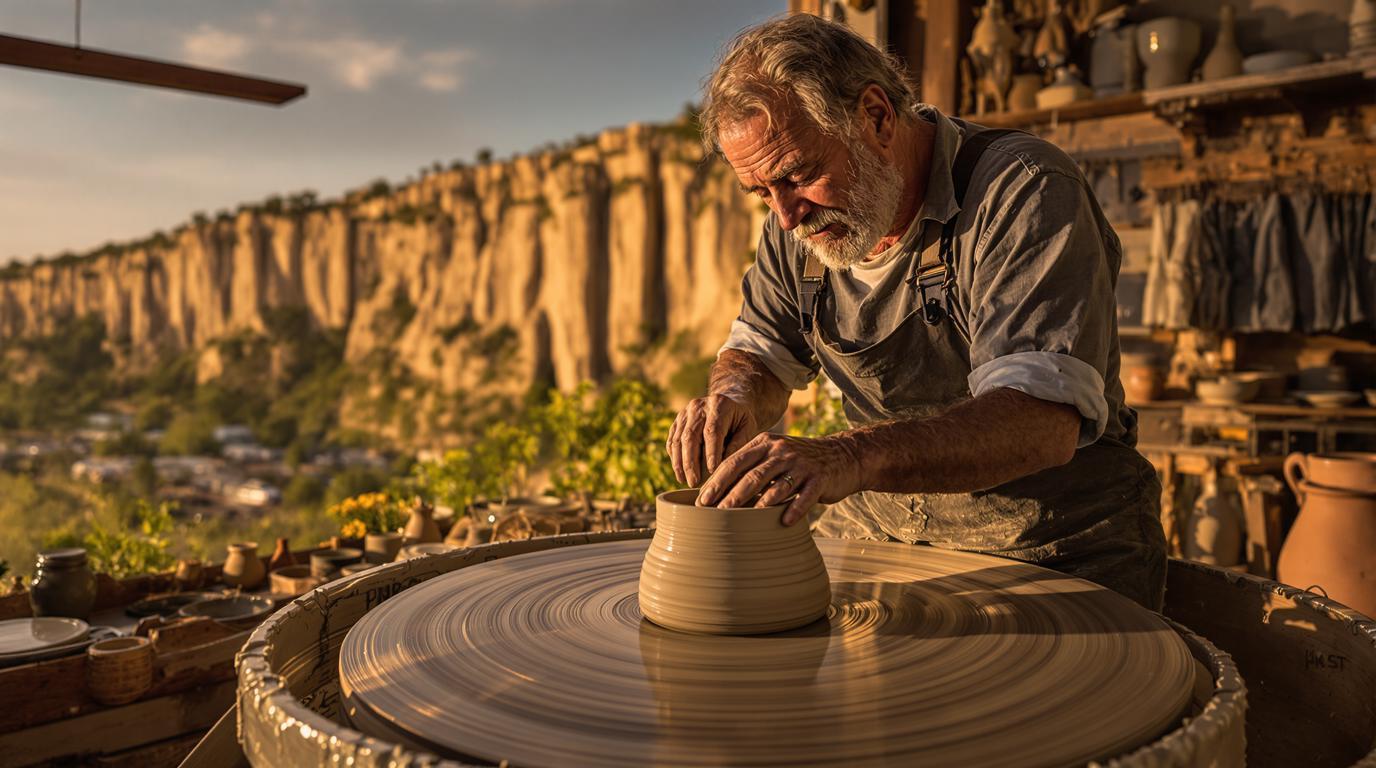The morning mist rises from the Mississippi River as I watch master potter Sarah Chen shape clay that carries the weight of 150 years of tradition. In this 16,756-resident sanctuary along Minnesota’s bluff country, locals have guarded their ceramic heritage with the same protective instincts that shield their dramatic river views from tourist crowds.
Red Wing sits at 748 feet above sea level, where the Mississippi carves through ancient bluffs that locals simply call “Minnesota’s pottery capital.” While thousands rush past on Highway 61 toward more famous destinations, this riverside town holds secrets that date back to 1877, when German immigrants first discovered the perfect river clay that would define generations.
What strikes you immediately isn’t just the stunning bluff formations or the historic downtown architecture. It’s the way locals speak about their pottery legacy with quiet pride, as if protecting something sacred from the outside world.
The 19th-century ceramic secret that time forgot
Where stoneware shaped American kitchens
The Red Wing Stoneware Company didn’t just make pottery in 1877—they revolutionized how America stored food. Walking through the remnants of the original factory district, you’ll discover where three competing companies, including Minnesota Stoneware and North Star, eventually formed the Union Stoneware cooperative in 1894. These weren’t decorative pieces for wealthy collectors; they were the sturdy crocks and jugs that kept pioneer families fed through brutal Minnesota winters.
The shift that changed everything
By the early 1900s, Red Wing’s potters had pivoted from utilitarian stoneware to art pottery and dinnerware that graced middle-class tables across America. The industry thrived until 1967, when mass production finally ended the era. Yet locals preserved the techniques, and today you can still find artisans maintaining these 19th-century traditions in ways that larger tourist destinations have long abandoned.
The bluff sanctuary that rivals Wisconsin’s tourist magnets
Barn Bluff’s geological drama
Rising dramatically from the Mississippi’s western bank, Barn Bluff offers hiking trails that locals prefer to keep quiet about. Unlike the crowded river towns of Stillwater or Hudson, Wisconsin, Red Wing’s bluff country remains refreshingly uncrowded. The limestone formations here tell stories of ancient seas and glacial carving that few visitors ever discover.
Summer’s hidden river access
The Red Wing Marina provides boat access to Mississippi River channels that most tourists never explore. While Wisconsin’s river towns charge premium prices for similar experiences, Red Wing’s authentic river culture remains accessible to those who know where to look. Local fishing guides speak of secluded backwaters where you can still experience the river as Mark Twain once knew it.
The pottery pilgrimage few travelers understand
Living collectors and forgotten treasures
The Red Wing Collectors Society operates with the dedication of archaeological preservationists, maintaining databases of pottery patterns that once filled American cupboards. Meeting these collectors reveals how Red Wing pottery became so embedded in American domestic life that most families owned pieces without knowing their Minnesota origins. These dedicated enthusiasts preserve cultural heritage with the same passion you’ll find in Europe’s most treasured ceramic regions.
The studios that survived
While industrial pottery production ended decades ago, Red Wing’s downtown still harbors artist studios where contemporary potters honor the original techniques. These aren’t tourist-focused shops but working studios where you can witness the same river clay being transformed by hands that learned from the last generation of factory workers.
Your insider access to Minnesota’s pottery capital
How locals experience their town
Summer brings the perfect combination of warm weather and active pottery workshops that locals recommend for serious visitors. The trick is arriving early in the morning when the Mississippi mist creates that magical light photographers dream about. Unlike heavily promoted historic towns, Red Wing rewards those who take time to explore beyond the obvious attractions.
Travel Note: Local potter Jim Morrison told me, “People drive through here heading to the Wisconsin Dells, never realizing they’re passing through America’s most authentic pottery town. We like it that way.”
Red Wing’s 16,756 residents have preserved something increasingly rare in American travel: authentic cultural heritage that exists for its own sake rather than tourist consumption. As summer crowds flock to Wisconsin’s manufactured attractions, this Mississippi River sanctuary continues its 150-year tradition of turning river clay into art, one careful hand at a time.
Essential questions about Red Wing’s pottery heritage
When is the best time to visit Red Wing’s pottery sites?
Summer months offer the most active pottery workshops and pleasant weather for exploring Barn Bluff’s hiking trails. The Red Wing Marina operates fully during summer, providing optimal river access for the complete experience.
How does Red Wing compare to other Midwest pottery destinations?
Red Wing’s pottery heritage predates most Midwest competitors by decades, with continuous production from 1877 to 1967. Unlike tourist-focused pottery towns, Red Wing maintains authentic working studios alongside its historical sites.
Can visitors still purchase authentic Red Wing pottery?
Original Red Wing pottery pieces are available through the Red Wing Collectors Society and local antique shops. Contemporary artists in downtown studios create new pieces using traditional techniques and local river clay.
What makes Red Wing’s pottery tradition unique?
The combination of perfect Mississippi River clay, German immigrant expertise, and continuous local tradition spanning 150 years creates a pottery heritage unmatched in the American Midwest. The town’s isolation from major tourist routes helped preserve authentic techniques.
